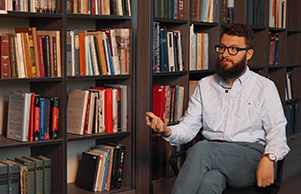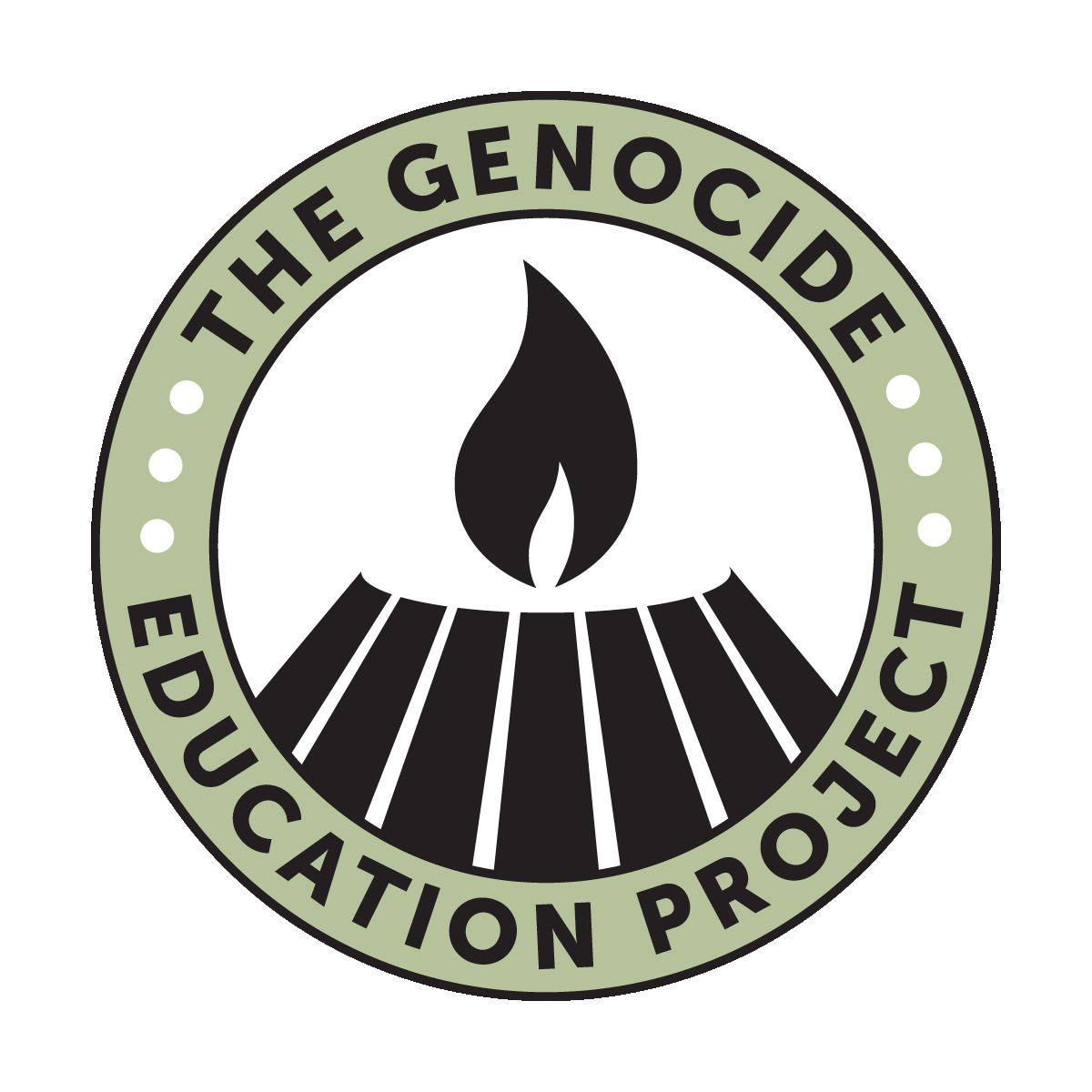08.07.2023

Հայոց ցեղասպանության թանգարան-ինստիտուտը մեկնարկում և շրջանառության մեջ է դնում նոր նախագիծ՝ «Հայոց ցեղասպանության հիշողության դեսպանի» ինստիտուտը: Այս մտահղացումը սերտորեն պայմանավորված է Հայոց ցեղասպանության հիշողությունների հավաքագրման հրատապության օրակարգով: Հայոց ցեղասպանության
հիշողության դեսպանն այն անձն է, ով հավաքագրում է աշխարհի տարբեր անկյուններից Հայոց ցեղասպանության վերաբերյալ պահպանված հիշողությունները՝ դրանք փոխանցելով Հայոց ցեղասպանության թանգարան-ինստիտուտին:
Հայոց ցեղասպանության առաջին
հիշողության դեսպանը Հայոց ցեղասպանությունը վերապրած Վարթեր Պողոսյանի ծոռն է՝ Դեյվիդ Հեքեթը: 2022 թ. նա ավարտել է Մասաչուսեթսի համալսարանը (Բոստոն, ԱՄՆ)՝ միջազգային հարաբերություններ մասնագիտացմամբ: Այժմ արդեն Ph.D. ուսանող է Քոլումբիայի համալսարանում: Դեյվիդը ՀՑԹԻ-ում «Դեպի Հայք» (Birthright Armenia) ծրագրով կամավորական աշխատանքներ (անգլերեն տեքստերի խմբագրում) է կատարել ընթացիկ տարվա փետրվար-մայիս ամիսներին: Ժամանելով Հայաստան՝ «Դեպի Հայք» ծրագրի շրջանակներում նա իր անձնական նախընտրությամբ ցանկություն է հայտնում որպես կամավոր աշխատել հենց ՀՑԹԻ-ում, ինչը ողջունելի էր մեզ համար. հիմք է դրվում արդյունավետ համագործակցության: Դեյվիդի անձնական հետաքրքրվածությունը, ոգևորիչ նվիրումն ու մասնագիտական կարողությունները ևս նպաստեցին ՀՑԹԻ
հիշողության դեսպանի գաղափարի վերարծարծմանը և շրջանառությանը: Իր հայկական արմատների ճանաչման մղումն է նրան նախևառաջ բերել Հայաստան. նա սկսել է հայերեն սովորել: Դեյվիդի կամավորության ընթացքում առաջին անգամ Հայաստան այցելեցին նրա մայրը, մորաքույրն ու զարմուհին, և մեզ փոխանցեցին իրենց տատիկի վերապրման պատմությունը: Իսկ նրա եղբայր Բրայանը մի քանի ամիս է, որ «Դեպի Հայք» ծրագրով կամավորական աշխատանք է կատարում Հայաստանում: Լիահույս ենք, որ Դեյվիդի օրինակը ոգևորիչ կլինի շատերի համար:
Ստորև կարող եք ընթերցել մեր հարցազրույցը Դեյվիդի հետ՝ բնօրինակ (անգլերեն) լեզվով:
Dear David, what made you decide to come to Armenia?
There are many reasons why I decided to travel to Armenia—some of them relate to my academic and professional goals, while others relate to my identity as a member of the Armenian diaspora.
First and foremost: my diasporic identity has played a role in my travels to Armenia. I am a fourth-generation immigrant to the United States, and my maternal grandmother was Armenian. Her mother, Varter Boghosian, was a survivor of the Armenian Genocide, and the story of her journey from the small village of Körpe, a settlement on the edge of Kharberd in Western Armenia, through the deportation caravans and eventual escape to Marseille was one which has always stayed close to my heart. Her odyssey has informed a large degree of my identity as an Armenian-American, and I feel strongly that my familial connection to the Armenian Genocide is one that has strengthened a deep personal interest in not only traveling to Armenia—but also chronicling and honoring the stories of others who were victims of crimes against humanity.
Another reason which influenced my decision to ultimately travel to Armenia relates to my professional and academic goals. Since my childhood, I have always been interested in the processes that “make the world work” across borders and oceans. I took an immense interest in geography, foreign languages and politics at school, and this translated to studying Political Science and International Relations during my undergraduate studies. In tandem with my interest with the preservation of memory, the prospect of contributing to the good work being done by researchers and policy activists across the South Caucasus to protect vulnerable populations and contribute to political security within the region fascinated me. That fascination translated well into the pursuit of work experience in a diverse region where I felt that I could continue to hone my professional and academic skillset while having my prior views on the world (ones shaped by a large degree of privilege as an American national) rightfully challenged and humbled in pursuit of this work.
Given both the professional and academic goals at stake and the opportunity to pay homage to Varter’s story as a survivor of the Armenian Genocide, my decision to come to Armenia was less a matter of “if I would come someday” and more a matter of “when I could go.” Having some time between teaching responsibilities and the start of a PhD in Political Science in September of 2023, I recognized that I had a window of time that I could spend in Armenia engaging in meaningful work while exploring my connection to my diasporic identity—and promptly made the decision to travel to Yerevan under the Birthright Armenia program during the fall of 2022. I arrived here in Armenia in January 2023 and have worked here since.
And following our first question comes the second one: why did you decide to volunteer at the Armenian Genocide Museum-Institute?
While I’ve always felt drawn to work and studies in the realm of Political Science, I have had a lifelong interest in human atrocity and chronicling the memories of survivors and victims of genocides and crimes against humanity. And while Varter’s story has undoubtedly shaped who I am today in every sense of the word, my interest in this unique discipline extends well beyond my own personal family history. Even as a child, the survival stories of those who’ve endured immense human tragedy have always resonated deeply with me: as a student, the stories of those who experienced the harrowing brutality of the Holocaust in Europe or those who faced the terror of the Rwandan Genocide as it happened were immensely humbling to absorb. That enduring interest never wavered between my formative schooling years and my undergraduate studies. It took some time for me to develop the confidence as someone who could contribute to this discipline, but having made my first few steps into research within the discipline of Genocide Studies, it’s been an immensely rewarding experience to focus my work on something that feels immensely purposeful and moral.
With this in mind, I had dreamed of making the pilgrimage to Tsitsernakaberd as the descendant of a survivor of the Armenian Genocide well-before my professional track reflected my interest in Genocide Studies. Once I learned that the Armenian Genocide Museum-Institute was open to volunteers from both Birthright Armenia and the Armenian Volunteer Corps, I immediately applied for a placement here at Tsitsernakaberd as my undisputed preference for a jobsite—and enthusiastically agreed to begin working at the AGMI once Deputy Director Edita Gzoyan reached out.
I have since spent the last four months working as a copy editor and researcher, having been given the resources and oversight to continue the research I started in the United States during my graduate studies. Even with my initial volunteer period coming to an end, I am eager to continue collaborating with the Institute from afar and return to campus for research as I begin my Ph.D in September of 2023. It is not an understatement to say that it is a dream to have been offered a research position here at Tsitsernakaberd, and I feel an immense sense of gratitude for Edita and the talented team of researchers and librarians who graciously invited me to join their ranks here on campus.
What have you discovered about your roots—and, perhaps, yourself—during your time here?
Speaking from a place of candor: I’ve been humbled—both in a sense of having become more aware of the biases I’ve carried as a researcher, and personally humbled as a self-identified member of the Armenian diaspora.
A key example of this: I wrote my master’s thesis last year on the activities of diaspora organizations as non-state actors at the local, state and systemic levels of governance—which focused on “perceived identity divisions” between Armenian nationals and diaspora communities around the world as the justification of disconnected communication between the Armenian state and its diaspora. Yet despite my initial confidence, I quickly discovered upon my arrival that I got a lot of things wrong in my research, and I saw that it was because I relied exclusively on academic work to furnish my research without setting foot on the ground here in the South Caucasus. On-site field work brings experiences with it that are unique, and it challenges your preconceptions of what you may bring with you to a new context.
Be it in simply adapting to a new work environment, surmounting linguistic and cultural barriers or—for me, personally—getting out of my comfort zone as a researcher and traveler, I have been humbled amid the opportunity to work here at Tsitsernakaberd. A key lesson I have already taken away from my experience here is to welcome the uncertainty of “not knowing” or making mistakes with my work, as well as embrace opportunities to learn and have my world view challenged.
How was your family’s experience when they visited the Armenian Genocide Museum-Institute?
In one word: cathartic. My mother, my aunt and my cousin came to visit me in Yerevan when my twin brother traveled to Armenia to begin his own Birthright experience—and while family connections played a large part in establishing that tangible rationale behind visiting Armenia, all three of them have a direct connection to Varter, having been old enough to spend their formative years with her. Collective trauma often is cited by social scientists as “transferrable” from generation to generation, and my family members’ experience as Varter’s granddaughters and grand-niece highlighted how the Genocide has touched their lives in very profound ways. Their visit to the Armenian Genocide Museum-Institute allowed us all to process our connection to it in a safe space.
My Aunt Joanne, in particular, had an emotional experience when visiting Tsitsernakaberd. Before sharing their story in an interview with Shushan Khatchryan, the museum’s Chief Oral Historian, Edita and AGMI Director Harutyun Marutyan warmly welcomed us all into the Director’s office. Then, Harutyun and Edita simply gave them the space to speak freely and tell Varter’s story—in which there were both bouts of contagious laughter in remembering fond memories while tears were shed in a space where it was welcome to address old wounds that the legacy of the Genocide had left on them. Harutyun, Edita and Shushan could not have made for more thoughtful, caring hosts. And for my family members who have shouldered an intergenerational trauma for much of their lives, they left warm impressions on my family that will endure for the rest of their lives.
As a son, nephew and cousin who has spent months on-site as a researcher and finding my own sense of spiritual connection to the memorial, given my familial connection to the Genocide, I learned things about my family that I had never been made aware of before when they came to the Armenian Genocide Museum-Institute; their visit to Armenia was largely motivated by the prospect of making the pilgrimage to the Tsitsernakaberd, and it was a truly humbling experience to bear witness to what seemed to be a healing experience for them to come to Tsitsernakaberd and process a degree of that inherited trauma.
For you: what is the significance of being the AGMI’s first “Ambassador of Memory?”
I am deeply touched to have been bestowed that title. As someone who feels a deep personal connection to the goals of the institution, I’m immensely grateful just to have been given the opportunity to be on-site conducting research and helping contribute to the work of the AGMI; given its novelty, to have even been considered as the institution’s first “Ambassador of Memory” is an honor that is both humbling and sobering.
Regardless of having received this honor, I am very excited to stay connected to the AGMI as I continue my studies and contribute to the exceptional work being done here at Tsitsernakaberd. Looking ahead to the future: I’m very eager to continue learning from the institution’s talented researchers, librarians and historians, and I welcome the opportunity to further broaden my perspective on the world.





